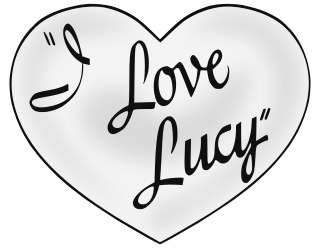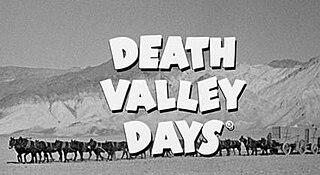
I Love Lucy is an American television sitcom that originally aired on CBS from October 15, 1951, to May 6, 1957, with a total of 180 half-hour episodes, spanning six seasons. The show starred Lucille Ball, her then real-life husband, Desi Arnaz, along with Vivian Vance and William Frawley. The series followed the life of Lucy Ricardo (Ball), a young, middle-class housewife living in New York City, who often concocted plans with her best friends, Ethel and Fred Mertz, to appear alongside her bandleader husband, Ricky Ricardo (Arnaz), in his nightclub. Throughout the show, Lucy is depicted trying numerous schemes to mingle with and be a part of show business. After the series ended in 1957, a modified version of the show continued for three more seasons, with 13 one-hour specials, which ran from 1957 to 1960. It was first known as The Lucille Ball-Desi Arnaz Show, and later, in reruns, as The Lucy–Desi Comedy Hour.

Alfred Hitchcock Presents is an American television anthology series created, hosted and produced by Alfred Hitchcock, aired on CBS and NBC between 1955 and 1965. It features dramas, thrillers and mysteries. Between 1962 and 1965 it was renamed The Alfred Hitchcock Hour. Hitchcock himself directed only 18 episodes during its run.

Tales from the Crypt, sometimes titled HBO's Tales from the Crypt, is an American horror anthology television series that ran from June 10, 1989, to July 19, 1996, on the premium cable channel HBO for seven seasons with a total of 93 episodes. The show's title is based on the 1950s EC Comics series of the same name and most of the content originated in that comic or other EC Comics of the time. The series is hosted by the Cryptkeeper, a wisecracking corpse performed by puppeteers and voiced by John Kassir.

Death Valley Days is an American old-time radio and television anthology series featuring true accounts of the American Old West, particularly the Death Valley country of southeastern California. Created in 1930 by Ruth Woodman, the program was broadcast on radio until 1945. From 1952 to 1970, it became a syndicated television series, with reruns continuing through August 1, 1975. The radio and television versions combined to make the show "one of the longest-running Western programs in broadcast history."

The Twilight Zone is an American anthology television series created and presented by Rod Serling, which ran for five seasons on CBS from 1959 to 1964. Each episode presents a stand-alone story in which characters find themselves dealing with often disturbing or unusual events, an experience described as entering "the Twilight Zone," often with a surprise ending and a moral. Although predominantly science-fiction, the show's paranormal and Kafkaesque events leaned the show towards fantasy and horror. The phrase "twilight zone," inspired by the series, is used to describe surreal experiences.

An anthology series is a radio, television, or film series that spans through different genres, and presents a different story and a different set of characters in each episode, season, segment or short. These usually have a different cast in each episode, but several series in the past, such as Four Star Playhouse, employed a permanent troupe of character actors who would appear in a different drama each week. Some anthology series, such as Studio One, began on radio and then expanded to television.

The Colgate Comedy Hour is an American comedy-musical variety series that aired live on the NBC network from 1950 to 1955. The show featured many notable comedians and entertainers of the era as guest stars. Many of the scripts of the series are archived at the UCLA Library in their Special Collections.
Ford Theatre, spelled Ford Theater for the radio version and known as The Ford Television Theatre for the TV version, is a radio and television anthology series broadcast in the United States in the 1940s and 1950s. At various times the television series appeared on all three major television networks, while the radio version was broadcast on two separate networks and on two separate coasts. Ford Theatre was named for its sponsor, the Ford Motor Company, which had an earlier success with its concert music series, The Ford Sunday Evening Hour (1934–42).
The Dinah Shore Show is an American variety show which was broadcast by NBC from November 1951 to July 1957, sponsored by General Motors' Chevrolet division. For most of the program's run, it aired from 7:30 to 7:45 Eastern Time on Tuesday and Thursday nights, rounding out the time slot which featured the network's regular evening newscast, which, like all such programs of the era, was then only 15 minutes in length.

The Paramount Television Network (PTN) was a venture by American film corporation Paramount Pictures to organize a television network in the late 1940s. The company built television stations KTLA in Los Angeles and WBKB in Chicago; it also invested $400,000 in the DuMont Television Network, which operated stations WABD in New York City, WTTG in Washington, D.C., and WDTV in Pittsburgh. Escalating disputes between Paramount and DuMont concerning breaches of contract, company control, and network competition erupted regularly between 1940 and 1956, and culminated in the dismantling of the DuMont Network. Television historian Timothy White called the clash between the two companies "one of the most unfortunate and dramatic episodes in the early history of the television industry."

The Bigelow Theatre is an American anthology series originally broadcast on CBS Television and on the DuMont Television Network.

The Silver Theatre is a television series that was broadcast on the CBS television network from 1949 to 1950. Hosted by Conrad Nagel, it was a live anthology series consisting of dramatic teleplays about romance. It was sponsored by the International Silver Company. Per an episode on the Internet Archive the series ran 25 minutes excluding commercials. There were a total of thirty-nine episodes.
Public Prosecutor was an American television series produced in 1947–1948, which first aired in 1951.
Your Jeweler's Showcase is an American television anthology drama series. At least 21 episodes aired on CBS from November 11, 1952 to August 30, 1953. From January 6, 1953 to May 26, 1953 it alternated weekly with Demi-Tasse Tales.
Stars Over Hollywood was an anthology series of "original comedies and light dramas" produced by Revue Productions. Revue's first television series, it was a filmed in Hollywood and aired on the National Broadcasting Company (NBC) from September 6, 1950 to August 29, 1951. There were a total of 50 episodes.
Frederic W. Ziv Company produced syndicated radio and television programs in the United States. Horace Newcomb's Encyclopedia of Television described the company as "by 1948 ... the largest packager and syndicator of radio programs" and later "the most prolific producer of programming for the first-run syndication market during the 1950s."









